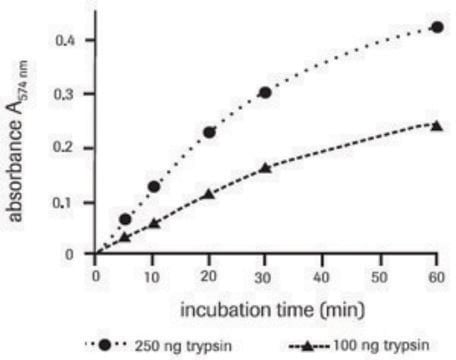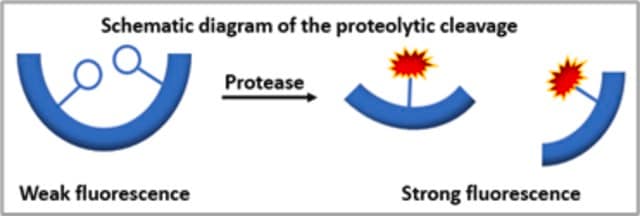PF0100
Protease Fluorescent Detection Kit
high sensitivity assay
Synonym(s):
Protease Assay Kit
Sign Into View Organizational & Contract Pricing
All Photos(3)
About This Item
UNSPSC Code:
12352202
NACRES:
NA.26
Recommended Products
shipped in
dry ice
storage temp.
−20°C
Application
Protease Fluorescent Detection Kit has been used:
- in the detection of proteolytic activity using casein based protease assay
- for testing the extracellular proteolytic activity of fungal strains
- for quantifying mitochondrial protease activity
- for measuring the protease production from soil solution
Suitability
Detection limit: approx. 50 ng trypsin
Quantity
Supplied with sufficient reagents for up to 200 one mL assays.
Supplied with sufficient reagents for up to 200 one mL assays.
The trichloroacetic acid (TCA) component is provided as 6.1 N TCA solution. 0.6 N TCA Solutions may be prepared by a 10-fold dilution of the desired volume of T0699 with ultrapure water. It is not necessary to dilute the entire volume of T0699 for immediate use of the kit.
The trichloroacetic acid (TCA) component is provided as 6.1 N TCA solution. 0.6 N TCA Solutions may be prepared by a 10-fold dilution of the desired volume of T0699 with ultrapure water. It is not necessary to dilute the entire volume of T0699 for immediate use of the kit.
Analysis Note
Tested for detection of all four proteolytic classes (serine, apartic, cysteine and metalloproteinases).
Kit Components Only
Product No.
Description
- Incubation buffer 25 mL
- FITC-casein solution 5 mL
- Assay buffer 200 mL
- Protease standard (trypsin) 20 μg
- FITC control 50 mg
- Trichloroacetic acid (TCA) solution 30 mL
Signal Word
Danger
Hazard Statements
Precautionary Statements
Hazard Classifications
Aquatic Acute 1 - Aquatic Chronic 1 - Eye Dam. 1 - Resp. Sens. 1 - Skin Corr. 1A - Skin Sens. 1 - STOT SE 3
Target Organs
Respiratory system
Storage Class Code
8A - Combustible corrosive hazardous materials
Flash Point(F)
Not applicable
Flash Point(C)
Not applicable
Choose from one of the most recent versions:
Certificates of Analysis (COA)
Lot/Batch Number
Don't see the Right Version?
If you require a particular version, you can look up a specific certificate by the Lot or Batch number.
Already Own This Product?
Find documentation for the products that you have recently purchased in the Document Library.
Dramatic increase in stability and longevity of enzymes attached to monodispersive iron nanoparticles.
Sharma A, et al.
IEEE Transactions on Magnetics, 43, 2418-2420 (2007)
Alejandro Soto-Gutiérrez et al.
Nature protocols, 2(2), 347-356 (2007-04-05)
This protocol describes a co-culture system for the in vitro differentiation of mouse embryonic stem cells into hepatocyte-like cells. Differentiation involves four steps: (i) formation of embryoid bodies (EB), (ii) induction of definitive endoderm from 2-d-old EBs, (iii) induction of
Joseph S Rom et al.
Virulence, 12(1), 584-600 (2021-02-05)
Using the USA300, methicillin-resistant Staphylococcus aureus strain LAC, we previously examined the impact of regulatory mutations implicated in biofilm formation on protease production and virulence in a murine sepsis model. Here we examined the impact of these mutations in the
Stimulation of soil organic nitrogen pool: The effect of plant and soil organic matter degrading enzymes
Kieloaho AJ, et al.
Soil Biology and Biochemistry, 96(10), 97-106 (2016)
Veronica Tjomsland et al.
European journal of immunology, 43(6), 1470-1483 (2013-03-26)
Induction of optimal HIV-1-specific T-cell responses, which can contribute to controlling viral infection in vivo, depends on antigen processing and presentation processes occurring in DCs. Opsonization can influence the routing of antigen processing and pathways used for presentation. We studied
Our team of scientists has experience in all areas of research including Life Science, Material Science, Chemical Synthesis, Chromatography, Analytical and many others.
Contact Technical Service











